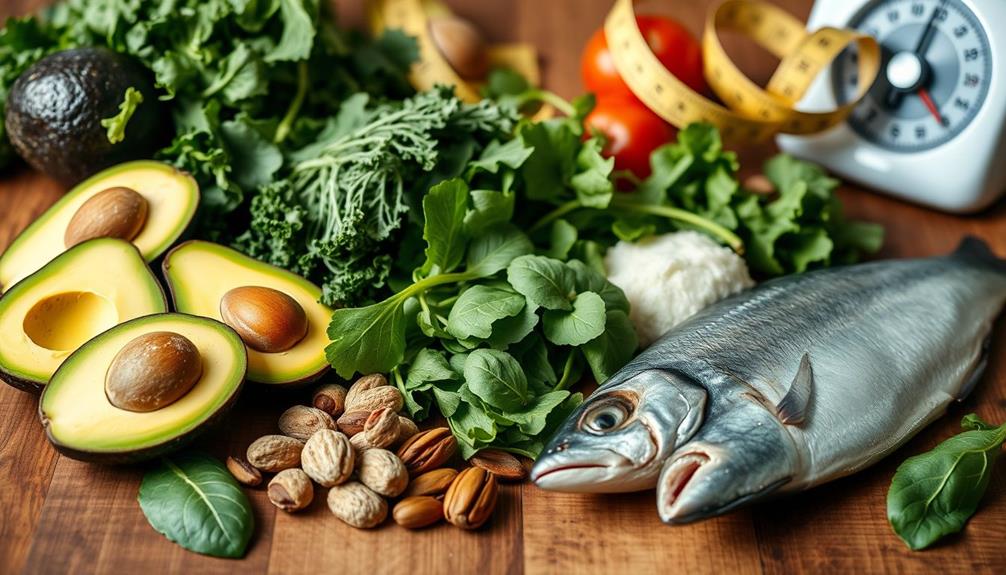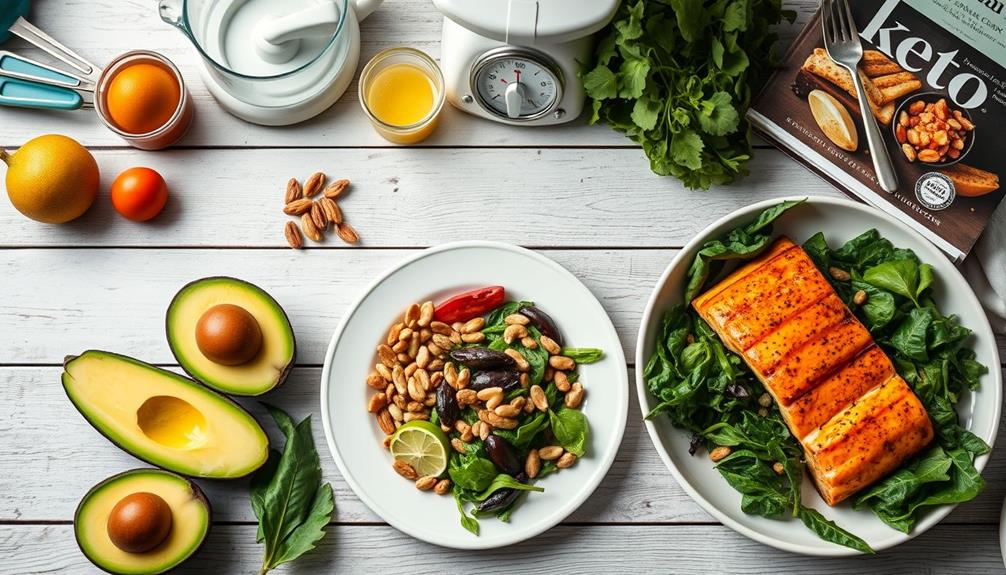To start the ketogenic diet for weight loss, aim to keep your carbohydrate intake below 50 grams per day. Focus on high-fat foods like avocados, nuts, and fatty fish, while incorporating low-carb vegetables such as spinach and zucchini. This approach shifts your body's energy source from carbs to fat, promoting a state called ketosis. Be prepared for initial side effects, often referred to as "keto flu," and stay hydrated to help manage these symptoms. Monitoring your food intake and planning meals can also keep you on track, and there's plenty more to explore about making keto work for you.
Key Takeaways
- Follow a high-fat, low-carbohydrate diet, keeping carbs below 50 grams daily to achieve ketosis.
- Incorporate essential high-fat foods like avocados, fatty fish, and full-fat dairy for satiety.
- Include low-carb vegetables such as spinach and broccoli to enhance meals without exceeding carb limits.
- Stay hydrated and increase electrolyte intake to combat initial side effects like fatigue and headaches.
- Track food intake and meal prep to maintain adherence to the ketogenic diet and avoid non-keto temptations.
Understanding the Ketogenic Diet

The ketogenic diet is a popular high-fat, low-carbohydrate eating plan that can greatly impact your weight loss journey. By considerably reducing your carbohydrate intake to less than 50 grams a day and increasing your fat consumption to around 70-80%, you can enter a state known as ketosis.
In ketosis, your body shifts from burning carbs for energy to burning fat, producing ketone bodies that serve as a crucial energy source for the brain. Daily consumption of antioxidant-rich foods can complement your keto diet by enhancing overall health.
Typically, it takes about 3-4 days of adhering to this high-fat diet for your body to enter ketosis. During this period, you might notice considerable weight loss, particularly from water weight as glycogen stores deplete.
Common foods included in the ketogenic diet are avocados, fatty fish, nuts, seeds, and low-carb vegetables. It's crucial to avoid grains, sugars, high-carb fruits, and starchy vegetables to maintain your low-carbohydrate eating plan.
Research shows that sticking to a ketogenic diet can help you lose an average of 2 pounds more than those following low-fat diets within the first few months, making it an appealing option for those looking to achieve lasting weight loss.
Key Food Choices for Keto

When choosing foods for your keto diet, focus on high-fat options like avocados, nuts, and fatty fish to meet your fat intake goals.
Incorporating foods that emphasize whole foods and low-glycemic options can further enhance your weight loss efforts.
You'll also want to add in low-carb vegetables such as leafy greens and zucchini to keep your meals balanced.
With the right food choices, you can effectively support your weight loss journey while enjoying tasty meals.
Essential High-Fat Foods
To successfully navigate the ketogenic diet, focusing on essential high-fat foods is crucial for achieving your weight loss goals. Incorporating healthy fats into your meals will help you stay satiated while keeping your carb intake low.
Additionally, understanding the impact of different food choices on your overall health can enhance your diet experience, especially since various brewing methods affect caffeine content considerably.
Start with avocados, which are packed with around 15 grams of monounsaturated fats per fruit. They're an excellent choice for boosting your fat intake.
Nuts and seeds, like almonds and chia seeds, also provide healthy fats, with almonds offering about 14 grams of fat per ounce. These options support your energy levels and satiety.
Fatty fish, such as salmon and mackerel, are another must-have. A 3-ounce serving of salmon delivers around 13 grams of omega-3 fatty acids and protein, promoting overall health.
Don't forget full-fat dairy products like cheese and heavy cream; cheddar cheese contains about 9 grams of fat per ounce, enhancing flavor and fat content in your meals.
Low-Carb Vegetables Options
Incorporating low-carb vegetables into your ketogenic diet is a smart way to add nutrients and bulk to your meals without tipping your carb count. Low-carb vegetables like spinach, zucchini, and kale contain less than 5 grams of net carbs per serving, making them excellent choices for maintaining ketosis. Including these vegetables can also help prevent health issues, similar to how cold medications can provide relief during illness.
Cruciferous vegetables such as broccoli and cauliflower are ideal for your weight loss journey. They're low in carbs yet high in fiber and vitamins, helping you stay full while providing essential nutrients.
Bell peppers and cucumbers also shine as versatile options, offering invigorating flavors with only about 3-4 grams of net carbs per cup—perfect for salads and snacks.
Don't overlook mushrooms; they contain just about 2 grams of net carbs per cup and can add great texture and flavor to your dishes.
Health Benefits of Keto

The ketogenic diet packs a punch when it comes to health benefits, making it a popular choice for those looking to shed pounds and improve overall well-being. One of the key ways the keto diet helps is through significant weight loss, with studies showing participants losing an average of 2 pounds more than those on low-fat diets.
As you follow the ketogenic diet, you'll likely notice a reduction in water weight initially, followed by sustained fat loss as your body adapts to burning fat for fuel. Additionally, the significance of key domains of development highlights how understanding individual health and lifestyle choices can impact overall well-being.
Furthermore, the keto diet can improve blood sugar levels, with around 60% of individuals with type 2 diabetes experiencing better control. Some even reverse their condition after just 16 weeks on this diet.
The diet also enhances insulin sensitivity, which is vital for metabolic health. You'll find that it promotes fat loss while preserving lean muscle mass, largely due to hormonal changes that regulate hunger and appetite.
Moreover, the ketogenic diet reduces chronic inflammation, lowering the risk of metabolic syndrome. With these combined health benefits, it's clear why many choose the keto lifestyle for weight loss and improved health.
Managing Side Effects

As you start your keto journey, you might encounter some common side effects, often referred to as "keto flu."
These symptoms can range from fatigue to headaches, which may be exacerbated by emotional fluctuations similar to those experienced by individuals with Borderline Personality Disorder (BPD).
But don't worry—there are effective strategies to manage them.
Common Side Effects
Many people experience common side effects when starting the ketogenic diet, often referred to as "keto flu." These symptoms, which can include fatigue, headaches, nausea, irritability, and muscle cramps, usually occur during the first week or two as your body adapts to ketosis.
During this initial adaptation phase, your body begins to excrete more water and electrolytes, which can contribute to these side effects. It's important to recognize that managing these symptoms can be similar to the financial considerations for elderly care, where planning and support play a vital role in easing changes.
To ease these symptoms, it's essential to stay well-hydrated and enhance your electrolyte intake. Focus on sodium, potassium, and magnesium to help combat fatigue and muscle cramps.
Gradually reducing your carbohydrate intake over a few days instead of cutting it out abruptly can also help minimize the severity of these side effects, allowing your body to adjust more smoothly.
Incorporating high-fiber, low-carb vegetables can support your digestive health, reducing the risk of constipation or diarrhea that may arise during the change.
If you find that side effects linger beyond the initial adaptation phase or become severe, it's wise to consult with a healthcare professional to guarantee proper management and address any potential underlying health issues.
Mitigation Strategies
During the initial weeks of your ketogenic journey, implementing effective mitigation strategies can greatly ease the change and reduce side effects like fatigue and irritability.
First, focus on hydration; drinking plenty of water can help combat the "keto flu." Increasing your electrolyte intake is also essential, as understanding common financial terms can also enhance your overall well-being. Incorporate foods rich in potassium, magnesium, and sodium, or consider supplements to maintain balance.
Gradually reduce your carbohydrate intake over a week rather than cutting it drastically. This approach allows your body to adapt more smoothly to ketosis.
To prevent constipation, include fiber-rich low-carb vegetables in your meals. They aid digestion and keep you feeling full.
Monitoring your ketone levels through breath, urine, or blood tests helps verify you're in ketosis. Adjust your diet if you experience symptoms of insufficient ketosis, like constant fatigue.
Finally, regularly include a variety of keto-friendly foods like fatty fish, avocados, nuts, and seeds. This variety helps prevent nutrient deficiencies and keeps cravings at bay, supporting your weight loss goals on the ketogenic diet.
Meal Planning Strategies

Planning your meals is essential for sticking to the ketogenic diet effectively. Start by establishing a macronutrient ratio of about 70-80% fat, 15-20% protein, and 5-10% carbohydrates. Incorporating healthy fats can also enhance your overall wellness, akin to using essential oils for health benefits.
Keep your daily carb intake below 50 grams to maintain ketosis. Focus on incorporating high-fat foods like avocados, olive oil, and fatty fish while avoiding grains, sugars, and starchy vegetables. This will help you create balanced meals that align with keto principles.
Meal prep is a game changer. Cook proteins and low-carb vegetables in batches to avoid the temptation of non-keto options on busy days. Explore keto-friendly recipes to add variety and keep your meals interesting. Options like zoodles or cauliflower rice can replace traditional high-carb staples without sacrificing taste.
Lastly, track your food intake using apps or food diaries. This will help you stay accountable to your macronutrient goals and pinpoint areas for improvement in your meal planning.
Long-term Success on Keto

Achieving long-term success on the keto diet hinges on consistency and adaptability. To effectively manage your approach, keep these key strategies in mind: High-quality content on nutrition can help you stay informed and motivated about your dietary choices, as content relevance and authority are prioritized in holistic SEO.
- Maintain a daily carbohydrate intake of 20-50 grams to stay in ketosis.
- Balance your macronutrient ratios: 70-80% fats, 15-25% protein.
- Regularly track your food intake to guarantee adherence and identify potential deficiencies.
- Implement meal prepping to avoid impulsive eating and guarantee keto-friendly options are on hand.
- Focus on hydration and electrolyte balance to mitigate common issues during adaptation.
Frequently Asked Questions
How Do I Start Losing Weight on Keto?
To start losing weight on keto, determine your daily macronutrient goals, plan meals with high-fat and low-carb foods, track your intake, and adjust as needed while staying hydrated and maintaining electrolyte balance during the shift.
How Do I Start My Keto Diet for the First Time?
Starting your keto journey's like diving into a retro video game! First, calculate your macronutrient needs, focus on high-fat foods, plan meals ahead, stay hydrated, and adjust based on how your body's responding. You've got this!
How Much Weight Can You Lose in a Month on Keto?
You can expect to lose between 5 to 15 pounds in your first month on keto, mainly due to water weight loss and reduced carb intake. Results may vary based on individual factors and adherence.
What Are the Basic Rules for Keto?
Following keto's basic rules is like steering through a maze; you limit carbs to under 50 grams daily, prioritize high-fat foods, track your intake, stay hydrated, and watch for signs of ketosis to guide you.
Conclusion
In your journey toward a healthier you, the ketogenic diet can be a fantastic fit. By focusing on fabulous fats and cutting carbs, you'll craft cravings into control. Remember to monitor your meals and manage those pesky side effects for sustainable success. Stay steadfast in your strategy, and you'll see the scale shift in your favor. Embrace the energy and excitement of a keto lifestyle, and soon, you'll be celebrating significant and satisfying results!









